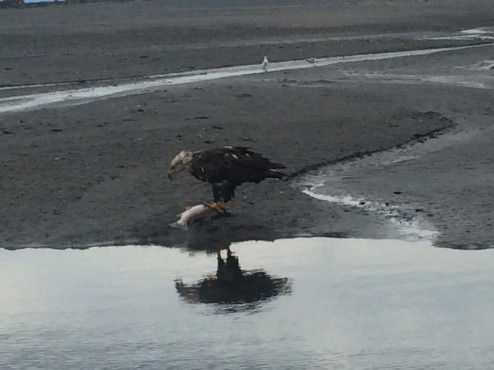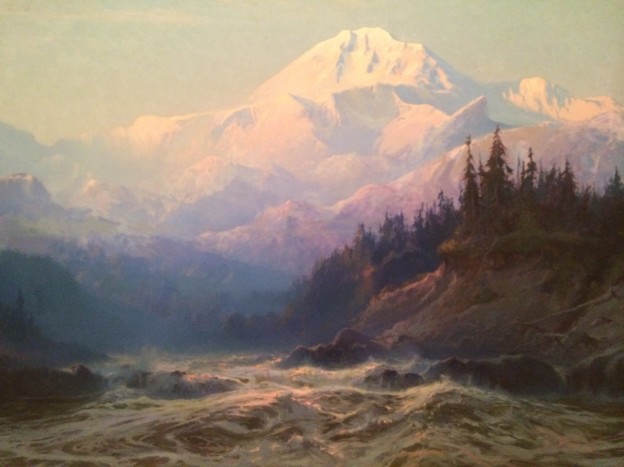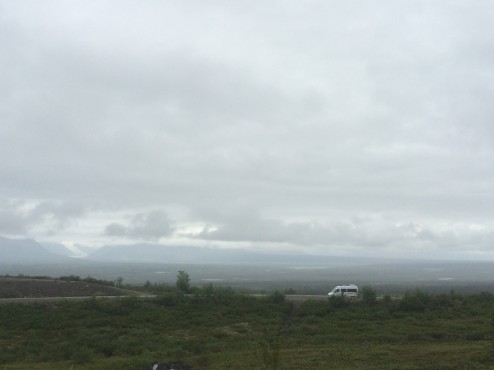Do you recall the goofy Holocaust Deniers who profess that Hitler didn’t really kill 6 million Jews. “It is all propaganda!”, they say. We are wondering if we should form a ridiculous organization called, “Denali Deniers”, to reflect the mass of propaganda suggesting you can view the 20,000 foot Mt. McKinley during the summer…just to lure tourists north of Anchorage. We featured this famous painting of Denali by Laurence, because we have not caught even a glimpse through the clouds after 4 weeks camping in the Alaska Range trying to see Denali from the North, East, and South. Local bush pilots say business is horrible this particularly wet and overcast summer as they honestly tell customers they will not see the tallest peak in North America in a flight around the summit. Fortunately the 4 mile wide Matanuska glacier is gorgeous and accessible by car, and the mosquitoes are less pesky than usual. So we’re told. Maybe that is Alaskan propaganda too. 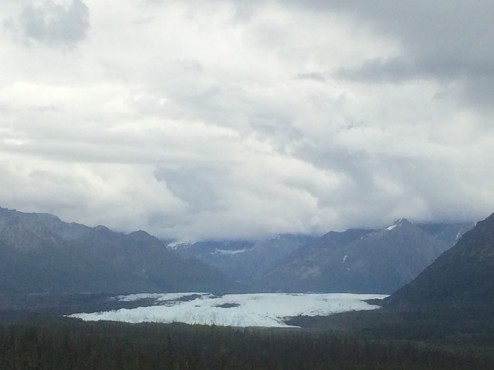 With so many ranges nearby to Anchorage (Alaska featuring Denali, Talkeetna, and the volcanic Aleutian Range) there are lots of peaks. When situated by the ocean, even measly 10,000 foot volcano Mount Illiamna is breathtaking.
With so many ranges nearby to Anchorage (Alaska featuring Denali, Talkeetna, and the volcanic Aleutian Range) there are lots of peaks. When situated by the ocean, even measly 10,000 foot volcano Mount Illiamna is breathtaking. 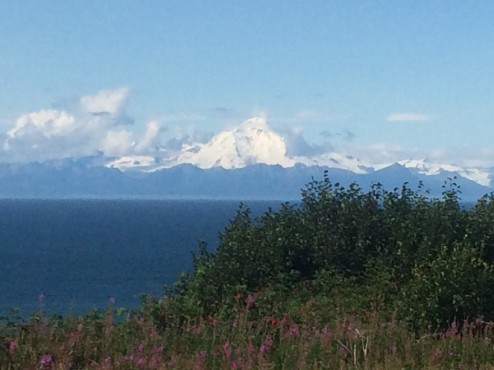 Yep, like cabbage, everything grows bigger here! Prehistoric cats, beavers and Mammoth Primigenius.
Yep, like cabbage, everything grows bigger here! Prehistoric cats, beavers and Mammoth Primigenius. 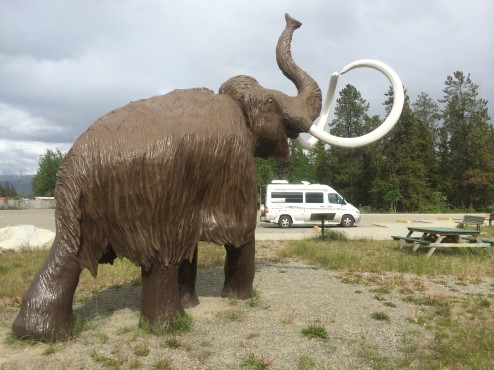 We feel excited to be on the eastern area of what used to be called Beringia. The Mammoth Steppes were the exposed parts of the Bering Sea when the last Ice Age sucked the ocean water into Glaciers. Beringia (mapped in green, below) remained the grassy home to Wooly Mammoths, Homo Sapien Sapien (the first humans in North America), and other mammals that crossed the Bering Land Bridge like our ancestors. The Mammoths, 14 feet tall with molars the size of shoe boxes, ate 700 lbs. of grass daily. As the grass disappeared, 11,000 years ago, so did Mammuthus Primigenius. The skills these First Americans devised to survive the severe environment included game surround and drive hunting, food preservation techniques, control of fire, constructed dwellings, stone and bone implements, and tailored clothing. These Ice Age Upper Paleolithic Eurasian-Beringians created a rich archeological record and then adapted over the centuries to environmental changes. I hope we have the same creativity and adaptive abilities as our ancesters…and don’t go the way of the wooly mammoths.
We feel excited to be on the eastern area of what used to be called Beringia. The Mammoth Steppes were the exposed parts of the Bering Sea when the last Ice Age sucked the ocean water into Glaciers. Beringia (mapped in green, below) remained the grassy home to Wooly Mammoths, Homo Sapien Sapien (the first humans in North America), and other mammals that crossed the Bering Land Bridge like our ancestors. The Mammoths, 14 feet tall with molars the size of shoe boxes, ate 700 lbs. of grass daily. As the grass disappeared, 11,000 years ago, so did Mammuthus Primigenius. The skills these First Americans devised to survive the severe environment included game surround and drive hunting, food preservation techniques, control of fire, constructed dwellings, stone and bone implements, and tailored clothing. These Ice Age Upper Paleolithic Eurasian-Beringians created a rich archeological record and then adapted over the centuries to environmental changes. I hope we have the same creativity and adaptive abilities as our ancesters…and don’t go the way of the wooly mammoths. 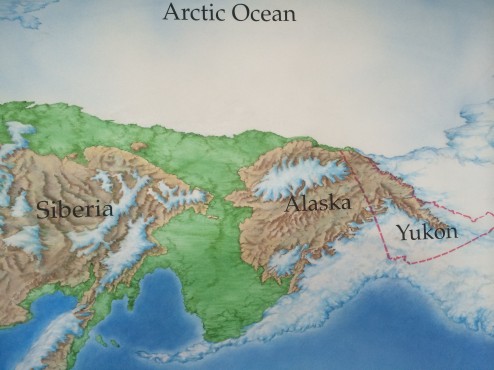 Other than ‘killah’ Southern BBQ (‘Bad to Da Bone BBQ’ sold out of a filling station convenience store!) we didn’t find much to extoll about Fairbanks, AK in summer. The military presence (27,000 U.S. Armed Forces in Alaska, especially dominant in Alaska’s second largest city of 30,000 residents), a preponderance of big box malls, and skid-row downtown area is surprising. The University of Alaska is here and these -40 below winters means people are inside making art, so where is it displayed? We imagine returning in Winter when covered with snow, under the Aurora Borealis, and with a view of Denali…if it really exists.
Other than ‘killah’ Southern BBQ (‘Bad to Da Bone BBQ’ sold out of a filling station convenience store!) we didn’t find much to extoll about Fairbanks, AK in summer. The military presence (27,000 U.S. Armed Forces in Alaska, especially dominant in Alaska’s second largest city of 30,000 residents), a preponderance of big box malls, and skid-row downtown area is surprising. The University of Alaska is here and these -40 below winters means people are inside making art, so where is it displayed? We imagine returning in Winter when covered with snow, under the Aurora Borealis, and with a view of Denali…if it really exists.
On the other hand, wet summer weather is more normal in Anchorage in August; the fascinating Anchorage Museum, good restaurants, 50 tennis courts, The Chugach mountains edging town for hiking, lots of bike trails, outside concerts (free!) and happy people outside enjoying 20 hours of daily light, make this city of 300,000 surrounded by sea and mountains, a great place to visit in Summer. It is much warmer in Winter due to the marine environment, but still has months with only 4 hours of light a day. On the other hand, the ski slopes are lighted up nightly until 10 PM for skiing after work! 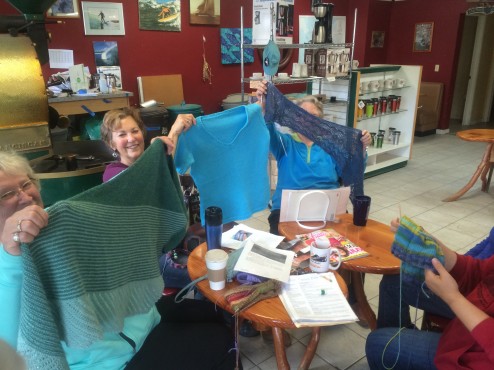 5 hours away by car, Homer is filled with artists and galleries. While Steven worked hard in a watercolor technique class, I chatted up the locals and hiked marshy trails in search of wildlife. Other than moose, I met up again with the noisy and guttural sandhill crane, except this time they are in every ditch and pond, and even blocking traffic in Homer.
5 hours away by car, Homer is filled with artists and galleries. While Steven worked hard in a watercolor technique class, I chatted up the locals and hiked marshy trails in search of wildlife. Other than moose, I met up again with the noisy and guttural sandhill crane, except this time they are in every ditch and pond, and even blocking traffic in Homer. 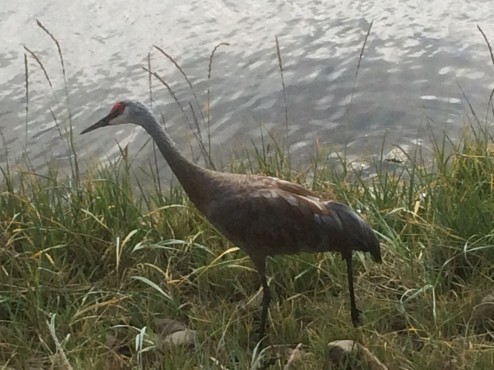 Homer is filled with anglers due to salmon and halibut, and there is plenty left for the bald eagles…until the pesky gulls slowly encroach on the kill forcing the eagle to fly off for more fishing and a quieter dining spot.
Homer is filled with anglers due to salmon and halibut, and there is plenty left for the bald eagles…until the pesky gulls slowly encroach on the kill forcing the eagle to fly off for more fishing and a quieter dining spot. 